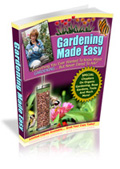Welcome to Gardening Guide
130. HOME VEGETABLE GARDENING Article

HOME VEGETABLE GARDENING
from:Home vegetable gardening is a wonderful and rewarding activity. It is a relaxing and inexpensive way to pass your leisure hours. Home vegetable gardening is healthy because it provides exercise and gets you out in the fresh air. It gives you a feeling of accomplishment to grow food with your own hands. Home vegetable gardening also helps cut down on the grocery bills. You can take your produce directly to the kitchen, or you can freeze or preserve your vegetable for use during the winter. Of course, you can also share the produce from your garden with friends and relatives. You don’t even need a plot of land to do home vegetable gardening, because many vegetables can be grown indoors in containers.
When you start home vegetable gardening you must consider several things. First, what sort of ground will you be planting in? Is it at the top of a hill or in a valley? Valleys are more susceptible to cold than hilltops. Is the ground exposed to wind? Such things create “micro-climates”, and some crops grow better in cooler or warmer micro-climates than others.
How much sunlight does your garden location get? Some crops require a lot of sunlight, while others do better in the shade. Can you increase the sunlight your garden plot receives by pruning back other foliage?
Are there trees growing on the ground where you plan to do home vegetable gardening? Trees can provide necessary shade for some crops like cucumbers, beets, carrots, cauliflower, radishes and spinach. But they also take water and nutrients from the soil. Plant your vegetable garden no closer than the outer reaches of a tree’s branches; preferable a few feet farther away than that.
If your yard has no flat areas on which to do home vegetable gardening, try terracing your ground. You can do that with timber or stone walls. Plant vegetables that like the warmest, sunniest conditions on the highest terraces, and those that can thrive in cooler temperatures at the bottom.
No matter how small your garden plot is, you can modify your garden’s mini-climate by using windbreaks, shade plants, mulches and irrigation. In places where the growing season is short, you can start some of your vegetables indoors in seed flats. These are small, open, well drained wooden boxes, usually twelve by twenty-four inches, and no less than three inches deep. You can even use things like cut-off milk containers, margarine or cottage cheese tubs, or foam or paper cups. Be sure to poke holes in the bottoms for drainage. When outdoor conditions are tight, transfer your baby plants to your garden.
Give your garden some time and effort, and before long you’ll be serving the fruits of your labour at the table.



